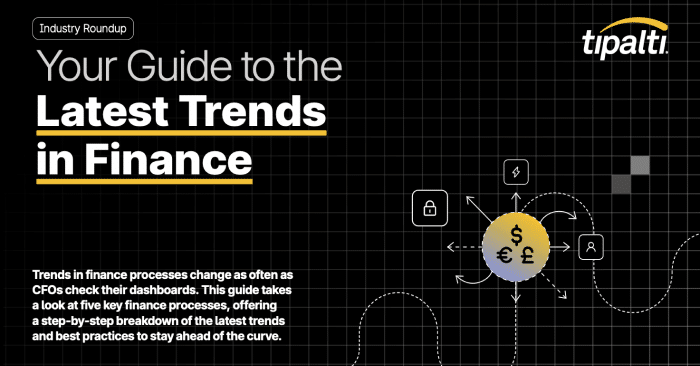
Finance trends shift fast—explore 5 key processes & tips to stay ahead.
Fill out the form to get your free eBook.

Trends in finance processes change as often as CFOs check their dashboards. This guide takes a look at five key finance processes, offering a step-by-step breakdown of the latest trends and best practices to stay ahead of the curve.
Today, the finance function has more responsibilities than ever. In high-growth small and mid-sized companies, every operation—both front and back-office—is inexplicably tied to investment versus reward. To survive the uncharted road ahead, the modern, forward-thinking finance team has to future-proof their organization for success.
Forging an Accounts Payable Path
Out of every function in finance, accounts payable is consistently ranked as the most time-consuming and problematic:
- AP is a cost center, money goes out but rarely comes in.
- AP is fueled by labor-intensive tasks.
- AP is ripe for inefficient processes that lead to costly errors, both financially and legally.
- AP is riddled with manual operations that may expose your company to fraud.
- AP delays the financial close process which damages visibility into performance.
The finance team protects your company’s cash—so, why is AP always the business function that is neglected?
Strategizing Your Next Move
Modern companies have successfully paved the way for transitioning accounts payable from invoice processors to strategic business partners. Their method? Creating processes and workflows that reengineer the AP process end-to-end, with a hyper-focus on these key functionalities:
- Improve efficiencies
- Reduce costs
- Ensure compliance with laws and regulations
- Improve payment strategy
- Protect against fraud and financial control risks
- Pay suppliers on time
- Positively improve the bottom line
- Close the books faster
Implementing a new AP workflow is an intimidating task, but with executive buy-in, clear and documented processes, and the right technology in place, you’ll find that the reward far outweighs the risk.
The Ultimate Accounts Payable Checklist
On the treacherous journey to a streamlined accounts payable process, what are the danger signs you should be looking for?
- Global Payments, you’re paying in multiple countries and currencies.
- Multi-Entity, you’re managing across several subsidiaries.
- Invoice Workflow, your current management process is manual or has limited capabilities.
- Financial Controls, your current controls don’t address role permissions, fraud, or regulatory screening in an audit-proof way.
- Tax & Regulatory Compliance, you’re manually collecting tax identity forms and validation for IRS and VAT compliance.
- Supplier Management, you’re managing banking and payment data collection and maintenance, not your suppliers.
- Reconciliation & Reporting, your financial reporting process takes weeks and is error-prone.
If this sounds like you, you might be lost in the AP wilderness, but you can put yourself on the right financial path with automation.
Automation—The Ultimate Survival Tool
Those laborious, manual tasks? Gone. Costly errors and increased fraud exposure? Eliminated.
By automatically tracking each payment, your finance team gains critical real-time insight into the AP process. Cloud-based systems let executives and managers access financial reports anytime, anywhere. Plus, suppliers gain visibility into their payment status and history on demand. With automation, your finance team is spending less time processing and more time strategizing—they can now tackle higher-value initiatives.
